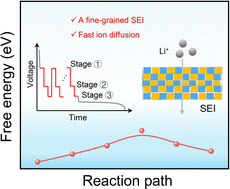Material Hardening Caused by Lattice Distortion Enables Good Cycling Stability of Entropy‐Increased Energy‐Storage Materials
Advanced Energy Materials, EarlyView.

Material hardening caused by lattice distortion is demonstrated as the underlying reason for the cycling-stability enhancement in entropy-increased energy-storage materials. The lattice distortion induced by doping/substitution in doped TiNb2O7 (Ti0.95V0.05Zr0.05Nb1.9Ta0.05O7) increases its material hardness and its reduced elastic modulus, thus hindering its particle breakage during repeated lithiation–delithiation, although its maximum unit-cell-volume change is larger than that of pristine TiNb2O7.
Abstract
Doping/substitution, which leads to an increase in configurational entropy, is a widely used approach to strengthen the electrochemical properties of energy-storage materials. Nevertheless, the key factor behind the enhanced cycling stability after the entropy increase remains elusive. Herein, via selective dopings of TiNb2O7 (TNO), an entropy-increased Ti0.95V0.05Zr0.05Nb1.9Ta0.05O7 (TNO-0.05) anode material is exploited, and an intrinsic link between the entropy increase and capacity-retention enhancement is revealed through a systematical study of this new material. As the dopant amount increases, the full-width at half-maximum of the X-ray diffraction (XRD) peaks of doped TNO monotonically widens, and thus the lattice distortion becomes severe. Significant lattice distortion with up to 427% larger lattice strain is introduced in TNO-0.05. Although the unit-cell-volume expansion of TNO-0.05 after lithiation is not reduced, the increased particle hardness, which originates from the increased lattice strain, effectively hinders particle breakage during repeated lithiation–delithiation. Consequently, TNO-0.05 delivers significantly improved cycling stability, showing approximately twice the capacity retention of TNO with a large active-material loading of 4.5 mg cm−2 after 500 cycles at 1250 mA g−1. Clearly, the material hardening caused by the lattice distortion can solve the structure-degradation problem in intercalation electrodes, undoubtedly promoting the exploitation of long-life energy-storage materials.


















































































![Four big takeaways to wrap up the Paris Air Show [Video]](https://breakingdefense.com/wp-content/uploads/sites/3/2023/06/FCAS-scaled-e1685718848105.jpg?#)
![The sights of Paris Air Show, one last time: Day 4 [Photos]](https://breakingdefense.com/wp-content/uploads/sites/3/2025/06/20250617-helenedelacoste-Paris-Air-Show-037-scaled-e1750357690820.jpg?#)



























































